
eBook - ePub
Preparing to Teach in the Lifelong Learning Sector
The New Award
Ann Gravells
This is a test
Condividi libro
- 176 pagine
- English
- ePUB (disponibile sull'app)
- Disponibile su iOS e Android
eBook - ePub
Preparing to Teach in the Lifelong Learning Sector
The New Award
Ann Gravells
Dettagli del libro
Anteprima del libro
Indice dei contenuti
Citazioni
Informazioni sul libro
This book is a guide to the PTLLS Award (which has been replaced with the Award in Education and Training) and is a comprehensive introduction to teaching in a variety of settings. This includes further education, adult and community learning, work-based learning, the forces and offender learning and skills. It is easy to read with plenty of practical activities and examples throughout and the content is fully linked to the Teacher Training Standards.
Please note: This book has since been updated to reflect the new title of the qualification: The Award in Education and Training.The qualification unit content contained in the appendices has since changed, and some legislation mentioned in the book has been updated.
Domande frequenti
Come faccio ad annullare l'abbonamento?
È semplicissimo: basta accedere alla sezione Account nelle Impostazioni e cliccare su "Annulla abbonamento". Dopo la cancellazione, l'abbonamento rimarrà attivo per il periodo rimanente già pagato. Per maggiori informazioni, clicca qui
È possibile scaricare libri? Se sì, come?
Al momento è possibile scaricare tramite l'app tutti i nostri libri ePub mobile-friendly. Anche la maggior parte dei nostri PDF è scaricabile e stiamo lavorando per rendere disponibile quanto prima il download di tutti gli altri file. Per maggiori informazioni, clicca qui
Che differenza c'è tra i piani?
Entrambi i piani ti danno accesso illimitato alla libreria e a tutte le funzionalità di Perlego. Le uniche differenze sono il prezzo e il periodo di abbonamento: con il piano annuale risparmierai circa il 30% rispetto a 12 rate con quello mensile.
Cos'è Perlego?
Perlego è un servizio di abbonamento a testi accademici, che ti permette di accedere a un'intera libreria online a un prezzo inferiore rispetto a quello che pagheresti per acquistare un singolo libro al mese. Con oltre 1 milione di testi suddivisi in più di 1.000 categorie, troverai sicuramente ciò che fa per te! Per maggiori informazioni, clicca qui.
Perlego supporta la sintesi vocale?
Cerca l'icona Sintesi vocale nel prossimo libro che leggerai per verificare se è possibile riprodurre l'audio. Questo strumento permette di leggere il testo a voce alta, evidenziandolo man mano che la lettura procede. Puoi aumentare o diminuire la velocità della sintesi vocale, oppure sospendere la riproduzione. Per maggiori informazioni, clicca qui.
Preparing to Teach in the Lifelong Learning Sector è disponibile online in formato PDF/ePub?
Sì, puoi accedere a Preparing to Teach in the Lifelong Learning Sector di Ann Gravells in formato PDF e/o ePub, così come ad altri libri molto apprezzati nelle sezioni relative a Education e Adult Education. Scopri oltre 1 milione di libri disponibili nel nostro catalogo.
Informazioni
1 TEACHING AND LEARNING
Introduction
In this chapter you will learn about:
- roles and responsibilities of a teacher
- boundaries of teaching
- record keeping
- legislation and codes of practice
There are activities and examples to help you reflect on the above which will assist your understanding of the process of teaching and learning. At the end of each section there are extension activities to stretch and challenge your learning further.
At the end of the chapter is across-referencing grid showing how the chapter’s contents contribute towards the professional teaching standards and PTLLS units.
Roles and responsibilities of a teacher
Most careers are quite challenging and demanding, and teaching is no exception to this. However, it can be very rewarding when you see your students’ achievements and success, which is a direct result of your contribution. Your main role as a teacher should be to teach your subject in a way that actively involves and engages your students during every session. However, it’s not just about teaching, it’s also about the learning that takes place as a result. You should use clear language at an appropriate level and in terms your students will understand, motivating them to want to learn more. You should also manage the learning process from when your students commence to when they complete, ensuring you assess their progress, give relevant feedback and keep appropriate records.
How you do this will depend upon your subject, the age and experience of your students and the environment you will teach in. Becoming a good teacher includes being enthusiastic and passionate about your subject, being approachable and taking pride in your work, which will all be conveyed to your students through your teaching approaches.
Example
Zak always arrives early to his sessions, he ensures the room is tidy and organises the tables and chairs in a way that encourages communication. He creates an approachable environment and delivers his subject with passion and enthusiasm. He uses lots of examples and anecdotes to relate his subject to real life. He includes all his learners by addressing them personally, yet remains fair with the support and advice he gives. He always tidies up afterwards and e-mails additional learning materials as required. His learners see how conscientious and professional Zak is and begin to emulate this by being early, being polite and submitting work on time.
A good first impression will help establish a positive working relationship with your students. The way you dress, act, respond to questions, offer support, etc., will also influence your students. They don’t need to know anything personal about you, but they will probably make assumptions about you. If asked personal questions, try not to give out any information: by remaining a professional, and not becoming too friendly, you will retain their respect. Most teachers are on first name terms with their students. However, you will need to decide what is appropriate to your situation. Establishing routines will help your sessions flow smoothly; for example, always starting on time, setting and keeping to time limits for activities and breaks, and finishing on time.
Activity
How could you create a good first impression with your students? What would influence this, for example your own previous experiences of attending a session?
The teaching and learning cycle
The teaching and learning cycle is so called as it can start at any stage and keep on going. However, all stages must be addressed for teaching and learning to be effective. The chapters in this book are based on the cycle, which consists of the stages outlined in Figure 1.1 below.
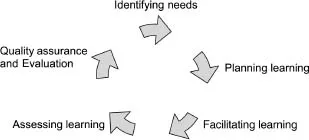
Figure 1-1 The teaching and learning cycle
Your role w ill usually follow the cycle and briefly involve:
- identifying needs – finding out what your organisation’s, your own, and potential students’ needs are, carrying out initial assessments, agreeing individual learning plans
- planning learning – preparing a scheme of work, session plans and teaching and learning materials to ensure you cover the requirements of the syllabus, liaising with others
- facilitating learning – teaching and facilitating learning using a variety of approaches
- assessing learning – checking your students have gained the necessary skills and knowledge
- quality assurance and evaluation – obtaining feedback from others, evaluating yourself and the programme in order to make improvements for the future. Evaluation should also be an ongoing process throughout all stages of the cycle.
Most teachers follow the cycle from beginning to end; however, your job role might not require you to be involved with all aspects. You will probably undertake a variety of roles during your teaching career, each having various responsibilities or duties that you must carry out. The job roles do not relate to whether you are employed full-time or part-time, but to the duties you will perform. There are two teaching roles in the further education sector in England:
- Associate teaching role which has fewer teaching responsibilities and will be performed by those who are expected to gain the status of Associate Teacher, Learning and Skills (ATLS). An Associate Teacher will usually teach using materials prepared by others.
- Full teaching role which represents the full range of responsibilities performed by those who are expected to gain the status of Qualified Teacher, Learning and Skills (QTLS). A Full Teacher will perform all aspects of the teaching and learning cycle.
Table 1.1 on page 12 lists examples of teaching roles and responsibilities, based on the teaching and learning cycle. Don’t be concerned by the amount of detail in the table; your job role might not require you to carry them all out. If there is anything you are unsure of at the moment, as you progress through the book it should all become clear.
To teach effectively involves not only the approaches you use to teach your subject, but many other factors that go before and after the taught session. This includes planning your sessions, preparing your teaching materials, assessing your students, marking work, giving feedback and evaluating yourself and the experience your students have. Never underestimate the amount of time you will need to dedicate to the role.
Table 1.1 Examples of teaching roles and responsibilities
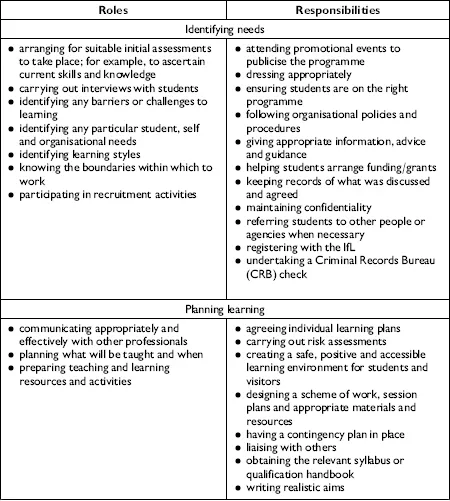
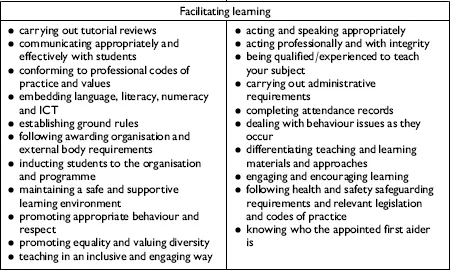

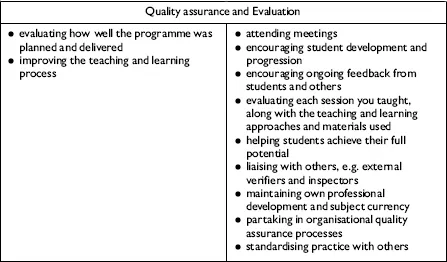
Your personality and mannerisms will be noticed by your students. You may do things you are not aware of; for example, waving your arms around or fidgeting. It is really useful to make a visual recording of one of your sessions to enable you to watch yourself afterwards. You may see things you didn’t realise you did or things that you would like to change. Smiling when you meet your students will help you and them relax.
If you are new to teaching, you may find you are teaching in the same way you were taught at school or college. This could be lecturing, reading from a book or writing information on a board, which might not have been very effective for you. You won’t yet know all the other methods you could use to make learning interesting and engaging. Active learning helps people remember; passive learning may lead them to forget. As you become more experienced at teaching, your confidence will grow and you will be able to experiment with different approaches, as not all teaching methods suit all students.
Extension Activity
Think about the subject you would like to teach, the age group of your students and the environment in which you will teach. What do you consider your roles and responsibilities will be to ensure learning is effective? If you are currently teaching, compare your responses with your job description.
Boundaries of teaching
You will have professional boundaries within which to work and it’s important not to overstep these by becoming too personal with your students. Boundaries are about knowing where your role as a teacher stops and working within the limits of that role. Table 1.2 on page 15 lists some of the boundaries you may encounter in relation to the teaching and learning cycle.
Example
Navinda had been teaching a group of 16 students once a week for six weeks. She occasionally e-mailed them between sessions to inform them of room changes. Two of her students sent her an e-mail inviting her to join their social networking site. She politely refused, to ensure that she remained professional in her role as their teacher.
Table 1.2 Boundaries of teaching
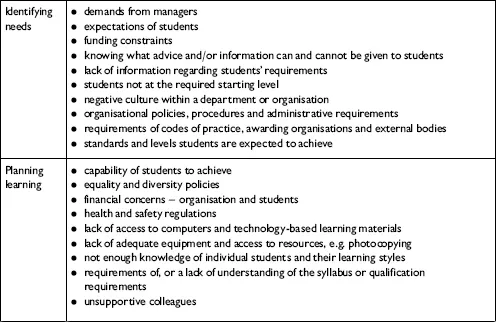

You need to remain in control, be fair and ethical with all your students and not demonstrate any favouritism towards particular students; for example, by giving one more support than the others. You might feel it sensible to make a telephone call to a student who has been absent but making regular calls would be inappropriate. Giving your personal telephone number to students could be seen as encouraging informal contact, and you may get calls or texts which are not suitable or relevant. You might not want to take your break with your students or join their social networking sites as you could become more of a friend than a teacher. It is unprofessional to use bad language, to touch students in an inappropriate way or to let your personal problems affect your work. Boundaries also include the constraints you might be under as a teacher; for example, the amount of paperwork you are expected to complete or the lack of fun...